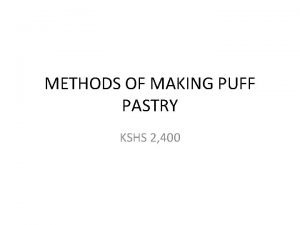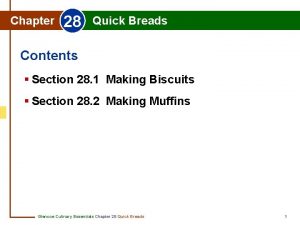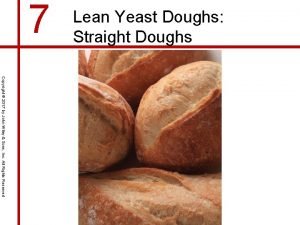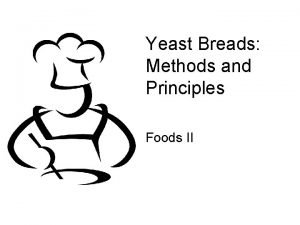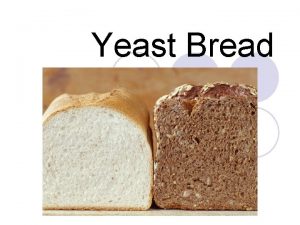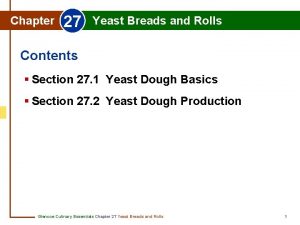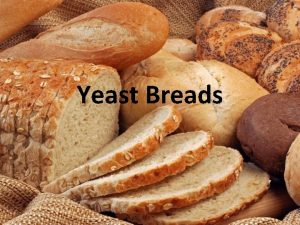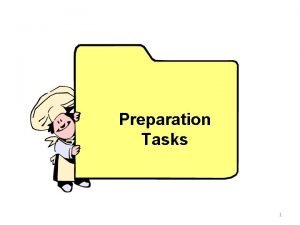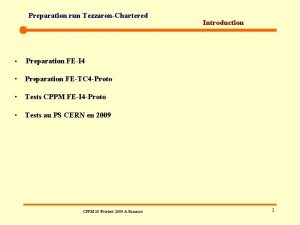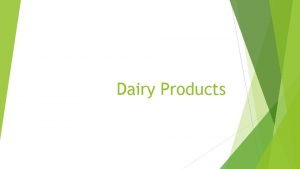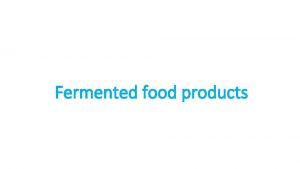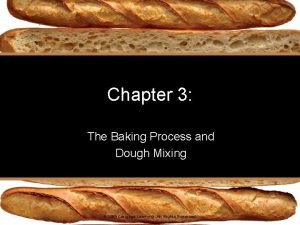Chapter 39 YeastRaised Products Dough Preparation Preparing dough
























- Slides: 24

Chapter 39 Yeast-Raised Products

Dough Preparation • Preparing dough for a yeast-raised bakery product is not as easy as preparing doughs and batters for quick breads • Yeasts are living organisms and require specific conditions to be effective leavening agents © Goodheart-Willcox Co. , Inc.

Using Yeast • Both compressed fresh yeast and granulated dried yeast need to be dissolved in liquid before adding the dry ingredients • Dissolve yeast in lukewarm liquid © Goodheart-Willcox Co. , Inc.

Using Yeast • Liquids at temperatures over 138°F (59°C) may kill the yeast organism • Proper conditions for fermentation are achieved by adjusting the temperature of the liquid © Goodheart-Willcox Co. , Inc.

Mixing and Kneading Dough • Mixing combines ingredients into a smooth mass with no dry spots or lumps • Kneading is done to develop gluten © Goodheart-Willcox Co. , Inc.

Mixing and Kneading Dough • Small quantities of dough can be kneaded by hand while larger quantities are usually kneaded in the mixer with the dough hook © Goodheart-Willcox Co. , Inc.

Mixing and Kneading Dough • Follow recipe directions for how long and at what speed dough should be kneaded to create a finished product with the right texture © Goodheart-Willcox Co. , Inc.

Fermentation • When yeast comes in contact with carbohydrates, the fermentation process begins • Loosely cover dough and leave it in a warm, draft-free place © Goodheart-Willcox Co. , Inc.

Fermentation • When fermentation is complete and the dough has risen to double its original size, it is punched © Goodheart-Willcox Co. , Inc.

Shaping the Dough • After fermentation and punching, dough is scaled to create loaves or individual rolls of a uniform size © Goodheart-Willcox Co. , Inc.

Shaping the Dough • A dough divider presses and cuts large quantities of dough into even portions © Goodheart-Willcox Co. , Inc.

Shaping the Dough • Most dough portions are first formed into balls, which helps the dough rise evenly and retain its shape during proofing and baking © Goodheart-Willcox Co. , Inc.

Shaping the Dough • Dough can be left in the form of a ball or formed into a wide variety of other shapes © Goodheart-Willcox Co. , Inc.

Proofing • Proofing is an important step in creating the volume and texture of the finished bread • Most bakeshops use a proof box with a temperature around 100°F (38°C) • The steam in the proof box prevents a dry crust from forming on the dough • Breads can also be proofed in a warm place covered with a clean cloth © Goodheart-Willcox Co. , Inc.

Proofing • When proofing is complete, the risen dough may be coated with a wash, which gives the dough a particular color or creates a textured crust © Goodheart-Willcox Co. , Inc.

Proofing • The most common wash is beaten eggs, which gives the finished bread a deep brown color and glossy finish © Goodheart-Willcox Co. , Inc.

Proofing • Another technique used for certain breads and rolls is docking • For bread with a hard crust, the slits allow gases to escape during the baking process © Goodheart-Willcox Co. , Inc.

Baking • Dough rises due to the expansion of the gases present in the dough • Yeast is killed, moisture evaporates, and the starches and gluten in the dough become firm © Goodheart-Willcox Co. , Inc.

Baking • The dough browns creating a crust © Goodheart-Willcox Co. , Inc.

Baking • Allow bread to cool to room temperature before slicing or serving © Goodheart-Willcox Co. , Inc.

Baking • Most bread is best stored at room temperature • Refrigeration causes bread to become stale more quickly • Baked breads can be frozen for long-term storage © Goodheart-Willcox Co. , Inc.

Technique: Preparing Yeast Breads 1. Weigh all ingredients carefully. 2. Dissolve compressed or dry active yeast in the liquid ingredients and mix with dry ingredients until fully incorporated. Instant yeast can be mixed directly into dry ingredients. © Goodheart-Willcox Co. , Inc.

Technique: Preparing Yeast Breads 3. Knead the dough for the prescribed amount of time either by hand or on the mixer using the dough hook. 4. Allow the dough to ferment until it has doubled in size. 5. Punch the dough. 6. Scale the dough into uniform portions. © Goodheart-Willcox Co. , Inc.

Technique: Preparing Yeast Breads 7. Shape the dough into the desired form. 8. Proof the dough until it doubles in size. 9. Bake according to recipe instructions. 10. Allow bread to cool to room temperature before serving. © Goodheart-Willcox Co. , Inc.
 Examples of functional and innovative products
Examples of functional and innovative products Pepsi vs coke marketing strategy
Pepsi vs coke marketing strategy Chapter 18 preparing for the world of work
Chapter 18 preparing for the world of work Chapter 18 preparing for the world of work
Chapter 18 preparing for the world of work Chapter 18 preparing for the world of work
Chapter 18 preparing for the world of work Chapter 15 preparing for careers
Chapter 15 preparing for careers Part 2 preparing a chart of accounts
Part 2 preparing a chart of accounts Chapter 1 preparing your path to success
Chapter 1 preparing your path to success What are the benefits of continuing education milady
What are the benefits of continuing education milady Chapter 12 preparing for the sale
Chapter 12 preparing for the sale Myjacks
Myjacks 3-2-1 pie crust examples
3-2-1 pie crust examples Straight dough method
Straight dough method English method puff pastry adalah
English method puff pastry adalah Define pithivier
Define pithivier What is laminated pastry
What is laminated pastry Hobo dough locations
Hobo dough locations What is the goal when making a pastry dough
What is the goal when making a pastry dough Quick breads and batters chapter 41 answers
Quick breads and batters chapter 41 answers Lean yeast dough
Lean yeast dough Soft medium dough examples
Soft medium dough examples What are the three classes of yeast bread?
What are the three classes of yeast bread? Enriched yeast dough
Enriched yeast dough Soft medium dough examples
Soft medium dough examples Rich yeast dough
Rich yeast dough













